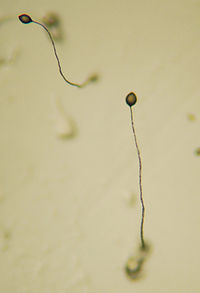
Photo from wikipedia
Among the amoebozoan species capable of forming fruiting bodies, the dictyostelid social amoebae stand out since they form true multicellular organisms by means of single cell aggregation. Upon food depletion,… Click to show full abstract
Among the amoebozoan species capable of forming fruiting bodies, the dictyostelid social amoebae stand out since they form true multicellular organisms by means of single cell aggregation. Upon food depletion, cells migrate across gradients of extracellular signals initiated by cells in aggregation centers. The model species that is widely used to study multicellular development of social amoebae, Dictyostelium discoideum, uses cyclic adenosine monophosphate (cAMP) as a chemoattractant to coordinate aggregation. Molecular phylogeny studies suggested that social amoebae evolved in four major groups, of which groups 1 and 2 are paraphyletic to groups 3 and 4. During early development, intercellular communication with cAMP appears to be restricted to group 4 species. Cells of group 1 and 2 taxa do not respond chemotactically to extracellular cAMP and likely use a dipeptide chemoattractant known as glorin ( N-propionyl-γ-L-glutamyl-L-ornithin-δ-lactam-ethylester) to regulate aggregation. Directional migration of glorin-responsive cells requires the periodic breakdown of the chemoattractant. Here, we identified an extracellular enzymatic activity (glorinase) in the glorin-responsive group 2 taxon Polysphondylium pallidum leading to the inactivation of glorin. We determined the inactivation mechanism to proceed via hydrolytic ethyl ester cleavage of the γ-glutamyl moiety of glorin. Synthetic glorinamide, in which the ethyl ester group was substituted by an ethyl amide group, had glorin-like biological activity but was resistant to degradation by glorinase. Our observations pave the way for future investigations toward an ancient eukaryotic chemotaxis system.
Journal Title: ACS chemical biology
Year Published: 2018
Link to full text (if available)
Share on Social Media: Sign Up to like & get
recommendations!